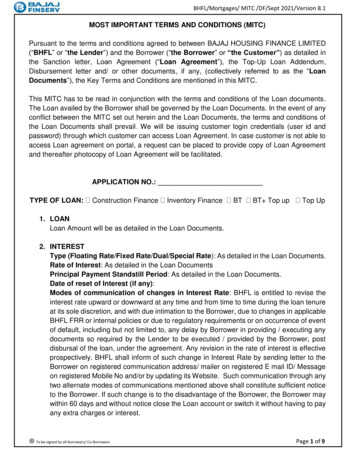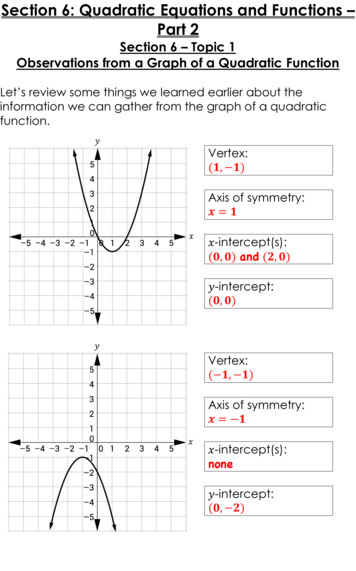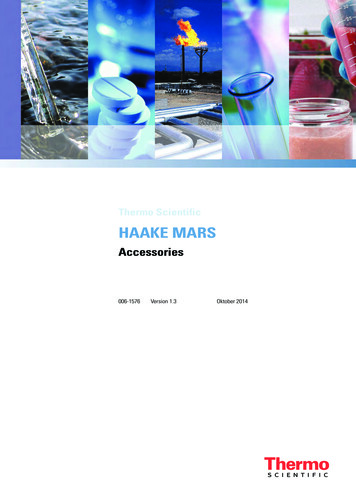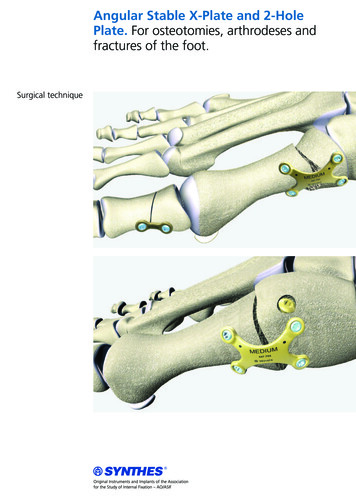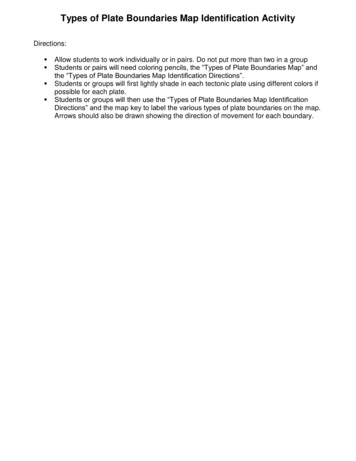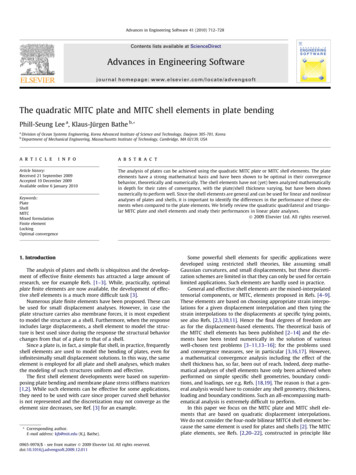
Transcription
Advances in Engineering Software 41 (2010) 712–728Contents lists available at ScienceDirectAdvances in Engineering Softwarejournal homepage: www.elsevier.com/locate/advengsoftThe quadratic MITC plate and MITC shell elements in plate bendingPhill-Seung Lee a, Klaus-Jürgen Bathe b,*abDivision of Ocean Systems Engineering, Korea Advanced Institute of Science and Technology, Daejeon 305-701, KoreaDepartment of Mechanical Engineering, Massachusetts Institute of Technology, Cambridge, MA 02139, USAa r t i c l ei n f oArticle history:Received 21 September 2009Accepted 10 December 2009Available online 6 January 2010Keywords:PlateShellMITCMixed formulationFinite elementLockingOptimal convergencea b s t r a c tThe analysis of plates can be achieved using the quadratic MITC plate or MITC shell elements. The plateelements have a strong mathematical basis and have been shown to be optimal in their convergencebehavior, theoretically and numerically. The shell elements have not (yet) been analyzed mathematicallyin depth for their rates of convergence, with the plate/shell thickness varying, but have been shownnumerically to perform well. Since the shell elements are general and can be used for linear and nonlinearanalyses of plates and shells, it is important to identify the differences in the performance of these elements when compared to the plate elements. We briefly review the quadratic quadrilateral and triangular MITC plate and shell elements and study their performances in linear plate analyses.Ó 2009 Elsevier Ltd. All rights reserved.1. IntroductionThe analysis of plates and shells is ubiquitous and the development of effective finite elements has attracted a large amount ofresearch, see for example Refs. [1–3]. While, practically, optimalplate finite elements are now available, the development of effective shell elements is a much more difficult task [3].Numerous plate finite elements have been proposed. These canbe used for small displacement analyses. However, in case theplate structure carries also membrane forces, it is most expedientto model the structure as a shell. Furthermore, when the responseincludes large displacements, a shell element to model the structure is best used since during the response the structural behaviorchanges from that of a plate to that of a shell.Since a plate is, in fact, a simple flat shell, in practice, frequentlyshell elements are used to model the bending of plates, even forinfinitesimally small displacement solutions. In this way, the sameelement is employed for all plate and shell analyses, which makesthe modeling of such structures uniform and effective.The first shell element developments were based on superimposing plate bending and membrane plane stress stiffness matrices[1,2]. While such elements can be effective for some applications,they need to be used with care since proper curved shell behavioris not represented and the discretization may not converge as theelement size decreases, see Ref. [3] for an example.* Corresponding author.E-mail address: kjb@mit.edu (K.J. Bathe).0965-9978/ - see front matter Ó 2009 Elsevier Ltd. All rights reserved.doi:10.1016/j.advengsoft.2009.12.011Some powerful shell elements for specific applications weredeveloped using restricted shell theories, like assuming smallGaussian curvatures, and small displacements, but these discretization schemes are limited in that they can only be used for certainlimited applications. Such elements are hardly used in practice.General and effective shell elements are the mixed-interpolatedtensorial components, or MITC, elements proposed in Refs. [4–9].These elements are based on choosing appropriate strain interpolations for a given displacement interpolation and then tying thestrain interpolations to the displacements at specific tying points,see also Refs. [2,3,10,11]. Hence the final degrees of freedom areas for the displacement-based elements. The theoretical basis ofthe MITC shell elements has been published [2–14] and the elements have been tested numerically in the solution of variouswell-chosen test problems [3–11,13–16]; for the problems usedand convergence measures, see in particular [3,16,17]. However,a mathematical convergence analysis including the effect of theshell thickness has, so far, been out of reach. Indeed, deep mathematical analyses of shell elements have only been achieved whenperformed on simple specific shell geometries, boundary conditions, and loadings, see e.g. Refs. [18,19]. The reason is that a general analysis would have to consider any shell geometry, thickness,loading and boundary conditions. Such an all-encompassing mathematical analysis is extremely difficult to perform.In this paper we focus on the MITC plate and MITC shell elements that are based on quadratic displacement interpolations.We do not consider the four-node bilinear MITC4 shell element because the same element is used for plates and shells [2]. The MITCplate elements, see Refs. [2,20–22], constructed in principle like
P.S. Lee, K.J. Bathe / Advances in Engineering Software 41 (2010) 712–728the shell elements, have a strong mathematical basis for linearplate analyses and show optimal convergence behavior, independent of the plate thickness, in mathematical analyses and numerical tests [23–26]. The disadvantage of these elements is that theyhave internal nodes that only carry rotational degrees of freedom.The use of these internal nodal rotations renders the quadraticMITC plate elements difficult to extend to shell and large deformation analyses. Also, in practice, the same degrees of freedom arebest used at each node of an element.It should be realized that, intrinsically, the development ofeffective shell elements is much more difficult than the development of plate elements because of the curvature effects in a shell,and the sensitivity of shells to curvature, boundary and loadingconditions [3,15]. Of course, once a shell element has been developed, the element is usually also tested in plate solutions. Considering the use of the MITC shell elements and the fact that the MITCplate elements have an optimal convergence behavior, a naturalquestion to ask is therefore ‘‘How much more powerful are theMITC plate bending elements when compared to the MITC shellelements in the linear analysis of plates?”The objective in this paper is to address this question by comparing numerically the performance of the quadratic MITC plateand MITC shell elements in the linear analysis of plates. In the nextsections we first briefly review the plate and shell elements, andwe then study the relative performance of the elements in sometypical plate analyses. We focus on the comparison of the triangular MITC7 plate and MITC6 shell elements, and the quadrilateralMITC9 plate and MITC9 shell elements in numerical tests. The elements of even higher order are hardly used in engineering practice713[27]. A mathematical convergence analysis of the MITC shell elements when used in linear plate analyses could be the objectiveof another paper.2. The MITC plate and MITC shell elementsAs well known, displacement-based shell elements using theReissner/Mindlin kinematical assumption and the plane stressassumption for the stress state are not effective because they lockin shear and membrane behavior [2]. The basic idea in the formulation of the MITC elements is to use the usual displacement interpolations for plates and shells, as for displacement-based elements,and ‘judiciously’ choose a corresponding strain interpolation. Theunknown parameters attached to the strain interpolations are thentied to the strain components obtained from the displacementinterpolations at ‘judiciously’ chosen tying points. In this way, thestrain parameters are eliminated and the only degrees of freedomof the element are the usual displacement and rotation degrees offreedom at the nodes, as for the displacement-based elements [2].This process of formulating elements can be used whenemploying Reissner/Mindlin plate theory to reach plate elements,and when using ‘the basic shell model’ underlying general shellelements [3,11,12] to reach shell elements. In the first case, theMITC plate elements and in the second case the MITC shell elements are obtained.The key to success of an MITC element formulation lies in the‘judicious’ choices for the strain interpolations and the tying pointsfor a given displacement interpolation. In essence, these choicesFig. 1. Nodal degrees of freedom, interpolation functions for the covariant strain components, and the tying points for the triangular elements considered.
714P.S. Lee, K.J. Bathe / Advances in Engineering Software 41 (2010) 712–728shall extract from the displacement-based strains, that make theelement almost useless, those components that render the elementto be effective: for plate elements, the aim is to remove shear locking, and for shell elements, the aim is to remove shear and membrane locking, where membrane locking in shell analysis isusually a more severe problem. At the same time, consistency inall strain terms needs to be preserved.It should be realized that the MITC formulation is quite differentfrom the ‘enhanced assumed strain’ formulation or ‘method ofincompatible modes’ [28]. Both techniques start with the displacement formulation and aim to improve its predictive capability. But,whereas in the MITC formulation, the strain assumptions inherently used in the displacement formulation are improved by notincluding certain terms of the displacement-based strain space,in the enhanced assumed strain formulations, new strain fieldsare added to those already inherently used in the displacementformulation. If this addition of strain terms actually results in asubtraction, in some cases, the same element matrices may bereached. However, more generally, the resulting elements aredifferent and considerably more computations are required inthe enhanced assumed strain formulations. Furthermore, anenhanced assumed strain formulation may be unstable in largedeformation analysis when the same formulation is stable in linearanalysis, see for example Ref. [29].The formulation of the MITC elements corresponds in fact to anapplication of the Hu–Washizu variational principle [2,4,13,14].However, this fact in itself, of course, does not mean that aformulated element is effective. The efficiency of an element needsto be analyzed mathematically, as far as possible, and testednumerically.As mentioned already, the elements we consider here have beenpublished before. Hence, in the following sections we only focus onthe specific items of the element formulations that are needed forthe understanding of our numerical results.2.1. Interpolation schemes for MITC plate and shell finite elementsFigs. 1 and 2 show the nodes, nodal degrees of freedom, andsummarize the interpolations used for the MITC plate and MITCshell elements that we test numerically in this paper. We note thatthe MITC7 and MITC9 plate elements have an internal node withonly rotational degrees of freedom, whereas the MITC6 and MITC9Fig. 2. Nodal degrees of freedom, interpolation functions for the covariant strain components, and the tying points for the quadrilateral elements considered. Note that weuse the improved MITC9 shell element and not the original MITC9 shell element [7].
715P.S. Lee, K.J. Bathe / Advances in Engineering Software 41 (2010) 712–728shell elements carry the same degrees of freedom at each node: forplate analysis, the transverse displacement and two section rotations. The MITC plate and shell elements are therefore clearly different. Note that in-plane strains are assumed in the MITC shellelements to avoid membrane locking, but such scheme is not used(and not needed) for the MITC plate elements.The MITC7 plate and MITC6 shell elements use the same interpolation polynomials for the transverse shear strain field. However,the coefficients in the interpolation functions are different because,for the MITC7 plate element, the coefficient for the interpolation ofthe transverse shear strain using the element center (r s 1/3) isevaluated by ert jA ¼ ðert jTA þ ert jTB þ ert jTC Þ 3; est jA ¼ ðest jTA þ est jTB þ est jTC Þ 3;ð1Þwhere the over-curl denotes the interpolation value used, and thedisplacement-based strains do not carry the curl.As shown in Fig. 2, the MITC9 plate and MITC9 shell finiteelements have different interpolation functions and tyingpoints for the transverse shear strains. For the MITC9 plateelement, the transverse shear strain ert at the element center isevaluated by ert jC ¼ ðert jA þ ert jB Þ 2:(a)ð2Þ(b)(c)Fig. 3. Square clamped plate problem under uniform pressure (L 1.0, E 1.7472 107 and v 0.3). (a) Problem solved; (b) 4 4 mesh of quadrilateral elements, N 4; and(c) 4 4 mesh of triangular elements, N 4.MITC7 plate el.MITC9 shell el.MITC9 plate -2-2.5-3-2.5-3log (relative error)0log (relative error)0log (relative error)log (relative error)MITC6 shell .5-4.5-5-5-5-5-5.5-1.5-1-0.5log (h)0-5.5-1.5-1-0.5log (h)0-5.5-1.5-1-0.5log (h)0-5.5-1.5-1-0.5log (h)0t/L 1/100t/L 1/1000t/L 1/10000Fig. 4. Convergence curves for the square clamped plate problem. The s-norm is used. The solid lines represent the theoretical convergence in Eq. (5).
716P.S. Lee, K.J. Bathe / Advances in Engineering Software 41 (2010) 712–728MITC7 plate el.MITC9 shell el.MITC9 plate -2-2.5-3-2.5-3log (relative error)0log (relative error)0log (relative error)log (relative error)MITC6 shell .5-4.5-5-5-5-5-5.5-1.5-1-0.5log (h)-5.5-1.50-1-0.5log (h)-5.5-1.50-1-0.5log (h)-5.5-1.50-1-0.5log (h)0t/L 1/100t/L 1/1000t/L 1/10000Fig. 5. Convergence of rotations for the square clamped plate problem. The solid lines represent the theoretical convergence in Eq. (3).MITC7 plate el.MITC9 shell el.MITC9 plate -2-2.5-3-2.5-3log (relative error)0log (relative error)0log (relative error)log (relative error)MITC6 shell .5-4.5-5-5-5-5-5.5-1.5-1-0.5log (h)0-5.5-1.5-1-0.5log (h)0-5.5-1.5-1-0.5log (h)0-5.5-1.5-1-0.5log (h)0t/L 1/100t/L 1/1000t/L 1/10000Fig. 6. Convergence of gradient of transverse displacement for the square clamped plate problem. The solid lines represent the theoretical convergence in Eq. (3).Considering these figures, the not-shown strain components areinterpolated in a symmetric manner.We should note that for the MITC7 and MITC9 plate element formulations, instead of the integral tying over the element surfacesprescribed theoretically for the MITC7 and MITC9 plate elementformulations, we use Eqs. (1) and (2), which was used and shownto be effective in Ref. [21].We also note that, in this study, the shear correction factor kwith value k 1 is used for all MITC plate and MITC shell finite element solutions [2].
717P.S. Lee, K.J. Bathe / Advances in Engineering Software 41 (2010) 712–728MITC7 plate elementMITC6 shell element6.00E-4Normalized transverse shear stressNormalized transverse shear stress1.60E-28.00E-30.00E -40.00E 0-2.00E-4-4.00E-4100.20.4MITC9 shell element0.81MITC9 plate element3.20E-58.00E-5Normalized transverse shear stressNormalized transverse shear stress0.6xx2.40E-51.60E-58.00E-60.00E 0-8.00E-600.20.40.60.86.00E-54.00E-52.00E-50.00E 0-2.00E-5100.20.4x0.60.81xN 2N 4N 8N 16ReferenceFig. 7. Distribution of the normalized transverse shear stress-xz along AB (t/L 1/10,000).MITC7 plate element4.00E-50.00E 02.00E-5Transverse shear stressTransverse shear stressMITC6 shell E 1MITC9 plate element4.00E-53.00E-53.00E-5Transverse shear stressTransverse shear stressMITC9 shell element4.00E-52.00E-51.00E-50.00E 0-1.00E-50.6x2.00E-51.00E-50.00E 000.20.40.6x0.81-1.00E-500.20.40.60.81xN 2N 4N 8N 16ReferenceFig. 8. Distribution of the normalized transverse shear stress-xz along AB (t/L 1/10,000). The stress is sampled at the mid-points of the element edges.
718P.S. Lee, K.J. Bathe / Advances in Engineering Software 41 (2010) 712–728MITC7 plate element1.20E-46.00E-36.00E-5Transverse shear stressTransverse shear stressMITC6 shell element8.00E-34.00E-32.00E-30.00E 0-6.00E-5-1.20E-40.00E 0-2.00E-300.20.40.60.8-1.80E-4100.20.4MITC9 shell element0.81MITC9 plate element2.00E-52.00E-50.00E 00.00E 0Transverse shear stressTransverse shear 0.81xN 2N 4N 8N 16ReferenceFig. 9. Distribution of the normalized transverse shear stress-yz along AB (t/L 1/10,000). The stress is sampled at the mid-points of the element edges.MITC7 plate element5.00E-50.00E 02.50E-5Transverse shear stressTransverse shear stressMITC6 shell 0E-3-8.00E-30.00E 000.20.40.60.8-7.50E-5100.20.40.81MITC9 plate element2.00E-50.00E 00.00E 0Transverse shear stressTransverse shear stressMITC9 shell .20.40.60.81xN 2N 4N 8N 16ReferenceFig. 10. Distribution of the normalized transverse shear stress-xz along DC (t/L 1/10,000). The stress is sampled at the mid-points of the element edges.
719P.S. Lee, K.J. Bathe / Advances in Engineering Software 41 (2010) 712–728MITC7 plate element3.00E-52.40E-32.00E-5Transverse shear stressTransverse shear stressMITC6 shell element3.20E-31.60E-38.00E-40.00E 0-1.00E-50.00E ITC9 plate element1.00E-57.50E-67.50E-6Transverse shear stressTransverse shear stressMITC9 shell element1.00E-55.00E-62.50E-60.00E 0-2.50E-60.6xx5.00E-62.50E-60.00E 000.20.40.60.81-2.50E-600.20.4x0.60.81xN 2N 4N 8N 16ReferenceFig. 11. Distribution of the normalized transverse shear stress-yz along DC (t/L 1/10,000). The stress is sampled at the mid-points of the element edges.2.2. Convergence estimatesThe theoretical convergence behavior of the MITC plate andMITC shell elements ideally reached in practice by the elementsconsidered in this study (but not yet proven to hold for the MITCshell elements), is given by h hh21where u denotes the exact solution and uh denotes the finite element solution.We will evaluate our numerical solutions with these three convergence rate estimates. To measure the convergence of the finiteelements in the plate bending problems with various plate thicknesses, we study the relative errors defined as4ffi ch ; w r whr20ð3Þ4ffi ch ; w are the rotation vector and the gradient vector ofwhere h and rthe transverse displacement of the exact solution hx w ¼ w;x ; h¼and rhyw;yð4Þ wh are the vectors of the finite element solution. In Eq.and hh and r(3), 1 and 0 denote the Sobolev norms [2,3], h is the elementsize and c is a constant, different in each equation.We will also use the s-norm ( s) proposed by Hiller and Batheto measure convergence of mixed formulations [7–9,16,17].24u uh ks ffi ch ;k ð5ÞE h ¼¼ hhhref href12;1 uhuref uref22Er w ¼ wref r whr wrefr220and Es02s:ð6ÞsTo calculate the quantities in Eq. (6), the finite element solu wref ; uref ) using very fine reference meshes are emtions ( href ; rployed instead of the exact solutions. The calculation procedureto evaluate the error measures using the reference and targetmeshes is presented in Ref. [17].In addition to giving the above convergence curves, we also present results in shear stress predictions. As well known, the shear stresses are very difficult to accurately calculate for thin plates and for the‘continuous’ problem theoretically do not even converge in the L2norm as t/L ? 0 [3]. Hence we simply plot the results along certainsections of the plates to show visually the convergence behaviors.
720P.S. Lee, K.J. Bathe / Advances in Engineering Software 41 (2010) 712–728(a)(b)(c)Fig. 12. Circular plate problem under uniform pressure (R L 1.0, E 1.7472 107, and v 0.3). (a) Problem solved. (b) Meshes for the MITC9 plate and shell elements, N 2and 4. (c) Meshes for the MITC7 plate and MITC6 shell elements (the center nodes are not used for the MITC6 shell element), N 2 and 4. The non-curved edges are due toplotting straight lines between element nodes.MITC7 plate el.MITC9 shell el.MITC9 plate -2-2.5-3-2.5-3log (relative error)0log (relative error)0log (relative error)log (relative error)MITC6 shell .5-4.5-5-5-5-5-5.5-1.5-1-0.5log (h)0-5.5-1.5-1-0.5log (h)0-5.5-1.5-1-0.5log (h)0-5.5-1.5-1-0.5log (h)0t/L 1/100t/L 1/1000t/L 1/10000Fig. 13. Convergence curves for the circular plate problem. The s-norm is used. The solid lines represent the theoretical convergence in Eq. (5).
721P.S. Lee, K.J. Bathe / Advances in Engineering Software 41 (2010) 712–728MITC7 plate el.MITC9 shell el.MITC9 plate -2-2.5-3-2.5-3log (relative error)0log (relative error)0log (relative error)log (relative error)MITC6 shell .5-4.5-5-5-5-5-5.5-1.5-1-0.5log (h)-5.5-1.50-1-0.5log (h)-5.5-1.50-1-0.5log (h)-5.5-1.50-1-0.5log (h)0t/L 1/100t/L 1/1000t/L 1/10000Fig. 14. Convergence of rotations for the circular plate problem. The solid lines represent the theoretical convergence in Eq. (3).MITC7 plate el.MITC9 shell el.MITC9 plate -2-2.5-3-2.5-3log (relative error)0log (relative error)0log (relative error)log (relative error)MITC6 shell .5-4.5-5-5-5-5-5.5-1.5-1-0.5log (h)0-5.5-1.5-1-0.5log (h)0-5.5-1.5-1-0.5log (h)0-5.5-1.5-1-0.5log (h)0t/L 1/100t/L 1/1000t/L 1/10000Fig. 15. Convergence of gradient of transverse displacement for the circular plate problem. The solid lines represent the theoretical convergence in Eq. (3).3. Numerical study of the MITC plate and MITC shell elementsIn this section, we give the numerical results of threerepresentative plate bending problems using the elements ofFigs. 1 and 2. We consider three linear problems of differentgeometries (square, circular and skew plates). In each case,we use very fine meshes with the MITC9 shell element toestablish the reference solutions. Three cases of plate thickness-to-length ratios (t/L) are considered, t/L 1/100, 1/1000and 1/10,000.
722P.S. Lee, K.J. Bathe / Advances in Engineering Software 41 (2010) 712–728MITC7 plate element4.50E-50.00E 03.00E-5Transverse shear stressTransverse shear stressMITC6 shell E-50.00E 0-1.50E-500.20.40.60.8-3.00E-5100.20.4x0.81MITC9 plate element6.00E-54.50E-54.50E-5Transverse shear stressTransverse shear stressMITC9 shell element6.00E-53.00E-51.50E-50.00E 0-1.50E-50.6x3.00E-51.50E-50.00E 000.20.40.60.8-1.50E-5100.20.4x0.60.81xN 2N 4N 8N 16Analytical sol.Fig. 16. Distribution of the normalized transverse shear stress-xz along AB (t/L 1/10,000). The stress is sampled at the mid-points of the element edges. The analyticalsolution is sxz 4.04 10 5x.MITC7 plate element4.00E-40.00E 03.00E-4Transverse shear stressTransverse shear stressMITC6 shell element2.00E-3-2.00E-3-4.00E-31.00E-40.00E 0.40.81MITC9 plate element4.00E-43.00E-43.00E-4Transverse shear stressTransverse shear stressMITC9 shell element4.00E-42.00E-41.00E-40.00E 0-1.00E-40.6xx2.00E-41.00E-40.00E 000.20.40.6x0.81-1.00E-400.20.40.60.81xN 2N 4N 8N 16Analytical sol.Fig. 17. Distribution of the normalized transverse shear stress-yz along AB (t/L 1/10,000). The stress is sampled at the mid-points of the element edges. The analyticalsolution is syz 0.
723P.S. Lee, K.J. Bathe / Advances in Engineering Software 41 (2010) 712–7284.00E-4N 2N 8N 32N 128Analytical sol.Transverse shear stress3.00E-42.00E-41.00E-40.00E 0-1.00E-400.20.40.60.81xFig. 18. Convergence of the normalized transverse shear stress-yz in the MITC9 shell element solutions. The analytical solution is syz 0 .(a)(b)(c)Fig. 19. Sixty-degree skew plate problem (L 1.0, E 1.7472 107, and v 0.3). (a) Problem solved; (b) 8 8 mesh used for quadrilateral elements; and (c) 8 8 mesh usedfor triangular elements.3.1. Analysis of a clamped square plate subjected to uniform pressureWe consider the plate bending problem shown in Fig. 3. Thesquare plate of dimension 2L 2L, with uniform thickness t, is subjected to a uniform pressure. All edges are clamped.Due to symmetry, only a quarter of the plate is modeled (the region ABCD shown in Fig. 3) with the following symmetry andboundary conditions imposed: hy 0 along BC, hx 0 along DC,w hx 0 along AB and w hy 0 along AD. Note that, along theclamped edges, the soft boundary condition is used and a strongboundary layer does not exist [30]. Fig. 3 also shows the mesh patterns used for N 4, the finer meshes are simply obtained by uniformly subdividing the elements. The reference mesh of MITC9shell elements for the calculation of the norms in Eq. (6) is givenby N 96.Figs. 4–6 present the curves of the three convergence measuresdiscussed in the previous section. The MITC9 shell finite elementgives uniform optimal (almost ideal) convergence curves for allthe cases of thickness t considered.Figs. 7–11 give the distributions of transverse shear stresses,normalized by the absolute value of the maximum bending stress,for the severe case of t/L 1/10,000. Of course, these shear stressesare small and difficult to predict accurately. The stresses have beencalculated by simply evaluating the shear strains at the points indicated, directly as obtained by the MITC interpolations given in Figs.1 and 2. Hence no stress smoothing or extrapolation from Gausspoints, or other points, has been performed.Fig. 7 shows the transverse shear stress sxz along the edge AB ofthe square plate calculated at the element nodes. Except for thesolutions of the MITC9 shell element, oscillations in the predictedstress are observed. Fig. 8 shows that, when the stress is sampledat the mid-points of the element edges, the MITC9 plate elementalso gives a reasonable approximation.Considering all results given in Figs. 7–11, the MITC9 shellelement predicts in this problem solution the transverse shearstresses with best accuracy.The oscillations in the shear stresses shown in Fig. 7 are typicalof all subsequent solutions as well, and hence we only show in
724P.S. Lee, K.J. Bathe / Advances in Engineering Software 41 (2010) 712–728MITC7 plate el.MITC9 shell el.MITC9 plate -2-2.5-3-2.5-3log (relative error)0log (relative error)0log (relative error)log (relative error)MITC6 shell .5-4.5-5-5-5-5-5.5-1.5-1-0.5log (h)-5.5-1.50-1-0.5log (h)-5.5-1.50-1-0.5log (h)-5.5-1.50-1-0.5log (h)0t/L 1/100t/L 1/1000t/L 1/10000Fig. 20. Convergence curves for the 60 skew plate problem. The s-norm is used. The solid lines represent the theoretical convergence in Eq. (5).MITC7 plate el.MITC9 shell el.MITC9 plate -2-2.5-3-2.5-3log (relative error)0log (relative error)0log (relative error)log (relative error)MITC6 shell .5-4.5-5-5-5-5-5.5-1.5-1-0.5log (h)0-5.5-1.5-1-0.5log (h)0-5.5-1.5-1-0.5log (h)0-5.5-1.5-1-0.5log (h)0t/L 1/100t/L 1/1000t/L 1/10000Fig. 21. Convergence of rotations for the skew plate problem. The solid lines represent the theoretical convergence in Eq. (3).
725P.S. Lee, K.J. Bathe / Advances in Engineering Software 41 (2010) 712–728MITC7 plate el.MITC9 shell el.MITC9 plate -2-2.5-3-2.5-3log (relative error)0log (relative error)0log (relative error)log (relative error)MITC6 shell .5-4.5-5-5-5-5-5.5-1.5-1-0.5log (h)0-5.5-1.5-1-0.5log (h)0-5.5-1.5-1-0.5log (h)0-5.5-1.5-1-0.5log (h)0t/L 1/100t/L 1/1000t/L 1/10000Fig. 22. Convergence of gradient of transverse displacement for the skew plate problem. The solid lines represent the theoretical convergence in Eq. (3).further results the values calculated at the mid-points of the element edges.3.3. Analysis of a simply-supported 60 skew plate subjected touniform pressure3.2. Analysis of a simply-supported circular plate subjected to uniformpressureFig. 19 shows the 60 skew plate we consider. The plate is subjected to a uniform downward pressure. All edges are simply-supported with w 0 at the edges, that is, the soft boundary conditionis imposed [30].Of particular difficulty in the solution of this plate problem arethe boundary layers and the stress singularity at the obtuse cornerB. To approximately resolve the boundary layers we use the gradedmesh patterns shown for N 8 in Figs. 19b and c. The same boundary layer length meshing is used for all cases t/L considered. Thereference solution for the calculation of the norms in Eq. (6) is obtained using the MITC9 shell element with N 128.Figs. 20–22 present the curves of the three convergence estimates. We note that, except for the gradient of the transverse displacement, the optimal rate of convergence is not obtained, whichhowever may be partly due to not resolving the boundary layerswell enough.For the transverse shear stress calculations we consider theplate with t/L 1/100, since the case t/L 1/10,000 is too severefor the purpose of this paper. Figs. 23 and 24 show the predicteddistributions of the transverse shear stresses along the edge AB.The stresses have been calculated as described in S
2.1. Interpolation schemes for MITC plate and shell finite elements Figs. 1 and 2 show the nodes, nodal degrees of freedom, and summarize the interpolations used for the MITC plate and MITC shell elements that we test numerically in this paper. We note that the MITC7 and MITC9 plate elements have an internal node with



